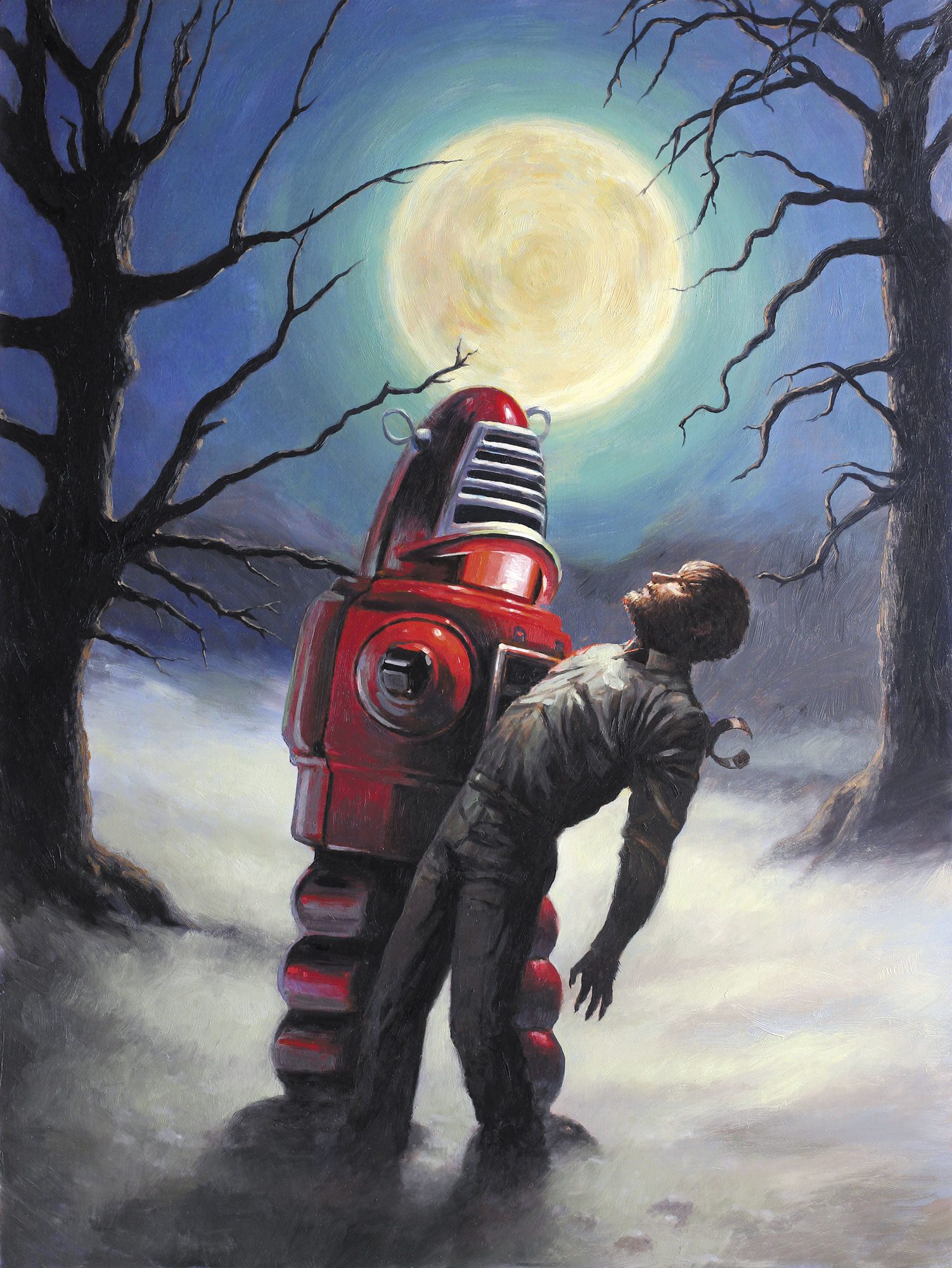
Werewolf Radar: Funnin’ With The Devil
By Nate Balding
Art by Eric Joyner
Published Issue 106, October 2022
Break out the fun size Snickers and a ball of cotton webbing you’ll be finding pieces of next June, because through the trick and/or treat of temporal experience the world has once again reached Checkpoint: Spooky. Even now the walls between realities wear thin. Howling across the moors is pitched a little brighter; spiders creepy-crawl with a little extra verve; dye jobs result in a sheen at once considered both classic and modern-chic. Return on spellcasting has inflated from threefold to fourfold for a brisk couple of weeks, and keen ears might register the warbling chorus of spirit children singing that classic hymn, “Tell Me About Your Pumpkin God” from their many shallow graves.
Yes, Hallowe’en has arrived stringing along its pals All Saints’ and Samhain and they brought a keg. Filled with beer? Nein, filled with blood! “Party like a ‘pire” as our hemophagic friends are fond of saying before they exsanguinate a tournament of virgins (yes, this is the correct terminology for a collection of persons unfamiliar to carnal purpose, originally referring to a specific Magic: The Gathering game held in August of 1994 — a period of time younger readers may not recall as predating the social acceptability of “nerd shit,” alternatively known as the Age of Mega Wedgies).
While no Halloween is complete without the ritual disfigurement of a porch-gourd, few can recount the legend presaging this most hallowed of ween-tivities. Like much of the lore surrounding this final threshold, before winter slips its fingers around the chilled bones of the Northern Hemisphere, it starts in a small Irish village and involves a drunkard. Feel free to insert your own joke here but be aware that it does make you at least a little bit racist.
Stingy Jack, so-named due to his parents’ intense distaste for their child, was well-known in his village for his frugality in all affairs, save those of the spiritual (read: Boozing). His public image was further besmirched by his insistence on carrying a sod-encrusted turnip for nibblin’ when the woozy waltz took him down the long road to forgetting to have enough cash for a better meal. Not to taste-shame a man for reflecting on his joie de goûter and finding there’s a simple, plentiful and, above all other things, inexpensive snack that travels well, but it’s kind of a hat on a hat, isn’t it?
As happens in somewhere between 100 percent and also 100 percent of Irish anecdotes from the oral tradition, Stingy Jack stumbles into fate’s boxing ring and waiting for the bell in the opposite corner stands the Lightbringer himself, weighing in at however much the collective misdeeds of humanity clock in at. Jack’s reputation was known to the devil who’d decided Jack ought to be relieved of his immortal soul posthaste. Remembering his first name was Stingy, Jack opposed any line of action depriving him of his property and formulated a plan. It was almost as good a plan as borrowing a piece of gum to cover your breath on the 2 a.m. trip to Taco Bell because it’s your car and besides you’d only had, what, seven beers? Eight? Nine? Whatever. But a plan nonetheless.
Stingy Jack pleads with the Lord of Lies and they come to an understanding. Jack would provide one (1) battered human soul and Old Scratch would let him have one last glug of his favorite ale. Thus acquiesced they travel to an inn where Jack gets his pint, the devil gets his soul and the barkeep doesn’t get anything because Jack doesn’t have any money. Apparently the two things Satan can’t beat are God and capitalism, because he’s on the hook for a tuppence and isn’t leaving until the bartender gets paid. For the second time in his life Jack bottles some lightning and ear-drops a win-win proposal. “‘Ow a-bout this,” he explains to the source of all evil on the material plane. “You turn yuhself inna a coin an’ pay wif it. Then— ” here he leans in to whisper, but accidentally loudly declares “— then you turn on back plain as morning sunshine, eh?” Good idea, thinks the once right hand of the Lord imbued with the powers of an omniscient deity. This all makes perfect sense.
So the stupid devil (an appellation given by historian Wirt Sikes in his classic, British Goblins, due to the amount of times in Welsh storytelling he’s easily thwarted by mischievous pedants — sometimes the real bits do the funny work) does the stupid thing and transforms into a stupid coin that Stingy Jack quickly pockets next to a crucifix, preventing the former leader of an undying army of angels charged with spreading love across a multiverse from being able to revert shape.
Tables turned, the ruler of a realm of torture beyond comprehension blubbers at Jack begging for release. On condition of retaining his soul for 10 more years, Jack does just that. One decade to the minute later: Jack is face-to-face with his old drinking buddy who — for reasons that actually unmake the concept of sense — agrees to allow Jack to climb an apple tree to get a bite for the trip to hell. Satan climbs up after him, that ragged, turnip-hardened soul nearly in his grasp. Jack leaps from the tree, carves a cross into the trunk and the stupid devil has once more entered the chat. The Lord of Darkness remains trapped in the branches until he agrees to never steal Jack’s soul.
Years later Stingy Jack rides the elevator to the afterlife but, due to his many dalliances with the wages of sin, doesn’t make it past the velvet ropes. He tries the back stairwell to the underworld but the devil remains true to his word and also refuses. Jack becomes a castaway stranded on earth but unable to partake of it, forever trudging along carrying nothing but his woe and his Wilson-esque companion: A turnip carved with a face, illuminated from within by the fires of hell. And that, friends in crow places, is the definitely true story of Jack of the Lanterns.

Have questions about the paranormal?
Send them to werewolfradarpod@gmail.com or on Twitter: @WerewolfRadar.
It’s a big, weird world. Don’t be scared. Be Prepared.
Nate Balding is a freelance humanoid who occasionally manifests in print and can most likely be seen at Werewolf Radar. Should you wish to hear him manifest audibly you can do so at the aforementioned Werewolf Radar’s associated podcast on Spotify and Apple, and if anything ever becomes humorous again, on a variety of stand up stages around the nation. If you’re truly craving further content there’s always @Exploder on Twitter — even if it is only a form of digital self flagellation at this point. His one thing that he considers actually accomplished was this time he was published in the journal Nature and then later collected into a volume called Futures from Nature, still available in places that have things.
Eric Joyner is a San Francisco-based artist who specializes in robots and donuts. Learn more about Eric and see more of his work on his site and on Instagram.
Check out Nate’s September install, Werewolf Radar: Strife On Mars, and Eric Joyner’s last piece, Robot Smack Down, or head to our Explore section to see more from these talented creatives.

Pingback: Werewolf Radar: A Hazy Shade of Geamhradh by Nate Balding | Art by Jason White - BIRDY MAGAZINE